Deck 7: Consumer Behavior
Question
Question
Question
Question
Question
Question
Question
Question
Question
Question
Question
Question
Question
Question
Question
Question
Question
Question
Question
Question
Question
Question
Question
Question
Question
Question
Question
Question
Question
Question
Question
Question
Question
Question
Question
Question
Question
Question
Question
Question
Question
Question
Question
Question
Question
Question
Question
Question
Question
Question
Question
Question
Question
Question
Question
Question
Question
Question
Question
Question
Question
Question
Question
Question
Question
Question
Question
Question
Question
Question
Question
Question
Question
Question
Question
Question
Question
Question
Question
Question

Unlock Deck
Sign up to unlock the cards in this deck!
Unlock Deck
Unlock Deck
1/130
Play
Full screen (f)
Deck 7: Consumer Behavior
1
Barbie is deciding whether to play soccer or go swimming over the next hour.She decides to swim.Economists would conclude that Barbie:
A) is revealing a preference for swimming over soccer.
B) will get less utility from swimming during the next hour than playing soccer.
C) was unable to play soccer at that time.
D) is more skilled at swimming than playing soccer.
A) is revealing a preference for swimming over soccer.
B) will get less utility from swimming during the next hour than playing soccer.
C) was unable to play soccer at that time.
D) is more skilled at swimming than playing soccer.
A
2
Utility is:
A) a quantitative measure of consumers' preferences.
B) an objective measure of a person's happiness.
C) as difficult to measure as an individual's income level.
D) a meaningful number measuring a consumer's precise level of satisfaction.
A) a quantitative measure of consumers' preferences.
B) an objective measure of a person's happiness.
C) as difficult to measure as an individual's income level.
D) a meaningful number measuring a consumer's precise level of satisfaction.
A
3
When economists observe someone make a choice,they assume the individual chooses:
A) what gives her the least utility.
B) what gives her the most utility.
C) what creates the most utility for society.
D) what is the most efficient choice.
A) what gives her the least utility.
B) what gives her the most utility.
C) what creates the most utility for society.
D) what is the most efficient choice.
B
4
Which of the following statements is true about individuals and utility?
A) Individuals seek to maximize utility.
B) Individuals seek to maximize their income, not utility.
C) Individuals will either minimize or maximize utility depending on the situation.
D) Individuals rarely try to maximize their utility.
A) Individuals seek to maximize utility.
B) Individuals seek to maximize their income, not utility.
C) Individuals will either minimize or maximize utility depending on the situation.
D) Individuals rarely try to maximize their utility.

Unlock Deck
Unlock for access to all 130 flashcards in this deck.
Unlock Deck
k this deck
5
Corey has a blue sweater and a denim jacket.On some days he chooses to wear the sweater but on others he chooses to wear the jacket.Economists would most likely conclude that:
A) Corey's preferences have changed.
B) Corey's preferences have not changed, but other factors may have changed such as the temperature outside.
C) Corey is irrational if he wears different clothing on different days.
D) Corey is indifferent between wearing a jacket or a sweater.
A) Corey's preferences have changed.
B) Corey's preferences have not changed, but other factors may have changed such as the temperature outside.
C) Corey is irrational if he wears different clothing on different days.
D) Corey is indifferent between wearing a jacket or a sweater.

Unlock Deck
Unlock for access to all 130 flashcards in this deck.
Unlock Deck
k this deck
6
Utility is:
A) maximized by rational individuals.
B) revealed by observing choices an individual makes.
C) the satisfaction individuals get from different bundles of goods.
D) All of these are true.
A) maximized by rational individuals.
B) revealed by observing choices an individual makes.
C) the satisfaction individuals get from different bundles of goods.
D) All of these are true.

Unlock Deck
Unlock for access to all 130 flashcards in this deck.
Unlock Deck
k this deck
7
Revealed preference is:
A) the idea that people's preferences can be determined by observing their choices and behavior.
B) the notion that people reveal the utility they get by reporting it on a numerical scale.
C) the method that psychologists, anthropologists, and economists use to measure utility.
D) All of these are true.
A) the idea that people's preferences can be determined by observing their choices and behavior.
B) the notion that people reveal the utility they get by reporting it on a numerical scale.
C) the method that psychologists, anthropologists, and economists use to measure utility.
D) All of these are true.

Unlock Deck
Unlock for access to all 130 flashcards in this deck.
Unlock Deck
k this deck
8
After browsing his cabinets to see what meals he can make,Ken is deciding whether to make nachos or spaghetti for dinner.If Ken makes spaghetti,we can conclude:
A) Ken doesn't like nachos.
B) Ken prefers nachos over spaghetti.
C) Ken will get more utility from making spaghetti for dinner than nachos.
D) None of these is true.
A) Ken doesn't like nachos.
B) Ken prefers nachos over spaghetti.
C) Ken will get more utility from making spaghetti for dinner than nachos.
D) None of these is true.

Unlock Deck
Unlock for access to all 130 flashcards in this deck.
Unlock Deck
k this deck
9
Bart is seen standing in front of the cooler that contains containers of iced tea and lemonade.Moments later,we see Bart drinking iced tea,and we conclude Bart is getting more utility from that drink than lemonade.We drew that conclusion based on what economic concept?
A) Revealed preference
B) Utility minimization
C) Satisfaction scales
D) Rational behavior
A) Revealed preference
B) Utility minimization
C) Satisfaction scales
D) Rational behavior

Unlock Deck
Unlock for access to all 130 flashcards in this deck.
Unlock Deck
k this deck
10
A utility function is:
A) an equation for calculating the most utility a particular person can derive.
B) an equation for calculating the total utility that a particular person derives from consuming a particular good over a particular time period.
C) an equation for calculating the total utility that a group of people derive from consuming a particular good.
D) an equation for calculating the total utility that a particular person derives from consuming a particular combination of goods and services.
A) an equation for calculating the most utility a particular person can derive.
B) an equation for calculating the total utility that a particular person derives from consuming a particular good over a particular time period.
C) an equation for calculating the total utility that a group of people derive from consuming a particular good.
D) an equation for calculating the total utility that a particular person derives from consuming a particular combination of goods and services.

Unlock Deck
Unlock for access to all 130 flashcards in this deck.
Unlock Deck
k this deck
11
Utility measurements are:
A) a relative ranking of how much different people enjoy a particular good.
B) used to compare one person's preference for a good to another person's preference.
C) a relative ranking of the satisfaction a person gets from alternative combinations of things.
D) None of these is true.
A) a relative ranking of how much different people enjoy a particular good.
B) used to compare one person's preference for a good to another person's preference.
C) a relative ranking of the satisfaction a person gets from alternative combinations of things.
D) None of these is true.

Unlock Deck
Unlock for access to all 130 flashcards in this deck.
Unlock Deck
k this deck
12
According to revealed preference a consumer that chooses to smoke cigarettes:
A) derives more utility from smoking than the goods they could have purchased with that same money.
B) derives more happiness from smoking than the goods they could have purchased with that same money.
C) is minimizing their utility given the options available to them.
D) is behaving irrationally.
A) derives more utility from smoking than the goods they could have purchased with that same money.
B) derives more happiness from smoking than the goods they could have purchased with that same money.
C) is minimizing their utility given the options available to them.
D) is behaving irrationally.

Unlock Deck
Unlock for access to all 130 flashcards in this deck.
Unlock Deck
k this deck
13
Bobby makes a New Year's resolution to lose weight.On January 3rd,he decides to go to Ben amp; Jerry's for ice cream instead of going to the gym.Using the concept of revealed preference,economists would most likely conclude that Bobby:
A) is not a rational individual.
B) actually gains more utility from ice cream than working out.
C) has changed his preferences.
D) has no choice over the actions he takes.
A) is not a rational individual.
B) actually gains more utility from ice cream than working out.
C) has changed his preferences.
D) has no choice over the actions he takes.

Unlock Deck
Unlock for access to all 130 flashcards in this deck.
Unlock Deck
k this deck
14
A bundle:
A) is a specific combination of goods and services an individual could consume.
B) describes the amount of people that choose a particular combination of goods.
C) is a curve describing different combinations of goods and services an individual could choose to consume.
D) is when a store sells goods at a discounted price.
A) is a specific combination of goods and services an individual could consume.
B) describes the amount of people that choose a particular combination of goods.
C) is a curve describing different combinations of goods and services an individual could choose to consume.
D) is when a store sells goods at a discounted price.

Unlock Deck
Unlock for access to all 130 flashcards in this deck.
Unlock Deck
k this deck
15
After browsing several pairs of shoes,Bob buys a pair of Nike running shoes.Economists would say that:
A) Bob is revealing his strong distaste for New Balance running shoes.
B) Bob is revealing he will always choose Nike over any other shoe brand.
C) Bob will get more utility per dollar from the Nike running shoes than any other in the store.
D) Bob made a poor choice, if he really prefers Adidas.
A) Bob is revealing his strong distaste for New Balance running shoes.
B) Bob is revealing he will always choose Nike over any other shoe brand.
C) Bob will get more utility per dollar from the Nike running shoes than any other in the store.
D) Bob made a poor choice, if he really prefers Adidas.

Unlock Deck
Unlock for access to all 130 flashcards in this deck.
Unlock Deck
k this deck
16
One baseline assumption that economists make about consumer behavior is that:
A) people are rational utility maximizers.
B) people will always choose short-term benefits to longer-term payoffs.
C) people will always choose what makes them happiest.
D) people are unpredictable.
A) people are rational utility maximizers.
B) people will always choose short-term benefits to longer-term payoffs.
C) people will always choose what makes them happiest.
D) people are unpredictable.

Unlock Deck
Unlock for access to all 130 flashcards in this deck.
Unlock Deck
k this deck
17
Utility is:
A) a way of describing a consumer's wants.
B) only applicable to goods that are purchased.
C) a measure of a consumer's income
D) All of these are true.
A) a way of describing a consumer's wants.
B) only applicable to goods that are purchased.
C) a measure of a consumer's income
D) All of these are true.

Unlock Deck
Unlock for access to all 130 flashcards in this deck.
Unlock Deck
k this deck
18
Utility is:
A) useful in comparing the relative satisfaction different consumers get from a particular good.
B) useful in predicting when to put an item on sale.
C) useful in quantitatively describing a person's preferences for one good over another.
D) an interesting concept, but not really useful for anything.
A) useful in comparing the relative satisfaction different consumers get from a particular good.
B) useful in predicting when to put an item on sale.
C) useful in quantitatively describing a person's preferences for one good over another.
D) an interesting concept, but not really useful for anything.

Unlock Deck
Unlock for access to all 130 flashcards in this deck.
Unlock Deck
k this deck
19
Billy is deciding whether to watch TV at home or go spend time with his friends.If Billy decides to stay home,we can conclude that:
A) Billy is a homebody and never goes out.
B) Billy will get more utility from watching TV than spending time with his friends.
C) Billy will regret not spending more time with his friends.
D) Billy's revealed preference is to always be alone.
A) Billy is a homebody and never goes out.
B) Billy will get more utility from watching TV than spending time with his friends.
C) Billy will regret not spending more time with his friends.
D) Billy's revealed preference is to always be alone.

Unlock Deck
Unlock for access to all 130 flashcards in this deck.
Unlock Deck
k this deck
20
Individuals will make choices to maximize their:
A) constraints.
B) utility.
C) income.
D) values.
A) constraints.
B) utility.
C) income.
D) values.

Unlock Deck
Unlock for access to all 130 flashcards in this deck.
Unlock Deck
k this deck
21
Linus has just watched two hours of TV.We can say:
A) his second hour of watching TV likely reduced his total utility.
B) his second hour of watching TV likely added less to his total utility than did the first.
C) if he watches a third hour it will likely decrease his total utility.
D) if he watches a third hour it will likely increase his total utility by at least as much as the second.
A) his second hour of watching TV likely reduced his total utility.
B) his second hour of watching TV likely added less to his total utility than did the first.
C) if he watches a third hour it will likely decrease his total utility.
D) if he watches a third hour it will likely increase his total utility by at least as much as the second.

Unlock Deck
Unlock for access to all 130 flashcards in this deck.
Unlock Deck
k this deck
22
After watching a movie,Alan chooses not to watch a second and goes for a walk instead.Economists could explain his choices using the concept of:
A) budget constraints.
B) diminishing marginal utility.
C) income effect.
D) substitution effect.
A) budget constraints.
B) diminishing marginal utility.
C) income effect.
D) substitution effect.

Unlock Deck
Unlock for access to all 130 flashcards in this deck.
Unlock Deck
k this deck
23
Alison is deciding how to spend the next hour.We ask her to rate the utility she would get from an hour of each activity.She would get utility of 4 from an hour of reading,utility of 2 from an hour of playing video games,and utility of 6 from jogging.Based on this information,economists could predict that Alison will:
A) read.
B) play video games.
C) go jogging.
D) do nothing, since none of the activities give her utility greater than 10.
A) read.
B) play video games.
C) go jogging.
D) do nothing, since none of the activities give her utility greater than 10.

Unlock Deck
Unlock for access to all 130 flashcards in this deck.
Unlock Deck
k this deck
24
Thinking about the total utility gained from the consumption of a typical good,we can say in general that:
A) total utility will rise, peak, and then decline as more and more units are consumed.
B) consuming more and more units of a good will eventually cause marginal utility to increase
C) total utility increases by decreasing amounts, until it is maximized. Then it declines.
D) total utility is maximized where the marginal utility is greatest.
A) total utility will rise, peak, and then decline as more and more units are consumed.
B) consuming more and more units of a good will eventually cause marginal utility to increase
C) total utility increases by decreasing amounts, until it is maximized. Then it declines.
D) total utility is maximized where the marginal utility is greatest.

Unlock Deck
Unlock for access to all 130 flashcards in this deck.
Unlock Deck
k this deck
25
Elijah has just eaten his second popsicle.Using the concept of marginal utility,we can say:
A) the utility he will gain from his third will reduce his total utility.
B) the utility he will gain from his third will not reduce his total utility.
C) the utility he will gain from his third will be less than that of his second but will increase his total utility.
D) the utility he will gain from his third will be less than that of his second and may reduce his total utility.
A) the utility he will gain from his third will reduce his total utility.
B) the utility he will gain from his third will not reduce his total utility.
C) the utility he will gain from his third will be less than that of his second but will increase his total utility.
D) the utility he will gain from his third will be less than that of his second and may reduce his total utility.

Unlock Deck
Unlock for access to all 130 flashcards in this deck.
Unlock Deck
k this deck
26
Grace has just eaten a slice of pizza and says it gave her a utility of 8.If she chooses to eat a second slice:
A) she will experience a drop in total utility.
B) she is not acting rationally.
C) she will experience an increase in total utility.
D) None of these is true.
A) she will experience a drop in total utility.
B) she is not acting rationally.
C) she will experience an increase in total utility.
D) None of these is true.

Unlock Deck
Unlock for access to all 130 flashcards in this deck.
Unlock Deck
k this deck
27
Nona has just gone on a bike ride for an hour and says it gave her a utility of 7.If she chooses to continue to ride her bike for another hour:
A) we can assume she will get at least a marginal utility of more than 7.
B) we can assume she will get a marginal utility of 7.
C) we can assume she will get a marginal utility of less than 7.
D) we can assume Nona's total utility will fall because of diminishing marginal utility.
A) we can assume she will get at least a marginal utility of more than 7.
B) we can assume she will get a marginal utility of 7.
C) we can assume she will get a marginal utility of less than 7.
D) we can assume Nona's total utility will fall because of diminishing marginal utility.

Unlock Deck
Unlock for access to all 130 flashcards in this deck.
Unlock Deck
k this deck
28
If successive units of a good are consumed,the marginal utility gained typically:
A) increases at the same rate for all people.
B) increases at different rates for different people.
C) decreases at the same rate for all people.
D) decreases at different rates for different people.
A) increases at the same rate for all people.
B) increases at different rates for different people.
C) decreases at the same rate for all people.
D) decreases at different rates for different people.

Unlock Deck
Unlock for access to all 130 flashcards in this deck.
Unlock Deck
k this deck
29
Sadie has just eaten a donut and says it gave her a utility of 6.If she chooses to eat another donut:
A) we can assume she will get an increase in utility of at least 6 from the additional donut.
B) we can assume she will get a decrease in utility from the additional donut.
C) we can assume she will get an increase in utility of less than 6 from the additional donut.
D) we can assume Sadie's total utility will fall because of diminishing marginal utility.
A) we can assume she will get an increase in utility of at least 6 from the additional donut.
B) we can assume she will get a decrease in utility from the additional donut.
C) we can assume she will get an increase in utility of less than 6 from the additional donut.
D) we can assume Sadie's total utility will fall because of diminishing marginal utility.

Unlock Deck
Unlock for access to all 130 flashcards in this deck.
Unlock Deck
k this deck
30
The concept of diminishing marginal utility:
A) explains why individuals rarely maximize their total utility.
B) is the change in total utility that comes from consuming one additional unit of a good or service.
C) is the principle that the additional utility gained from consuming successive units of a good or service tends to be smaller than the utility gained from the previous unit.
D) is the principle that the additional utility gained from consuming different bundles of goods and services tend to be smaller than the utility gained from consuming just one bundle of goods and services.
A) explains why individuals rarely maximize their total utility.
B) is the change in total utility that comes from consuming one additional unit of a good or service.
C) is the principle that the additional utility gained from consuming successive units of a good or service tends to be smaller than the utility gained from the previous unit.
D) is the principle that the additional utility gained from consuming different bundles of goods and services tend to be smaller than the utility gained from consuming just one bundle of goods and services.

Unlock Deck
Unlock for access to all 130 flashcards in this deck.
Unlock Deck
k this deck
31
The marginal utility gained from the consumption of successive units of a typical good:
A) tends to decrease.
B) tends to increase.
C) may increase or decrease depending on the cost of the good.
D) tends to stay the same.
A) tends to decrease.
B) tends to increase.
C) may increase or decrease depending on the cost of the good.
D) tends to stay the same.

Unlock Deck
Unlock for access to all 130 flashcards in this deck.
Unlock Deck
k this deck
32
Howard has just smoked a cigarette.If he chooses to smoke a second one:
A) he will experience a drop in total utility.
B) he is not acting rationally.
C) he will derive less marginal utility from it than his first.
D) None of these is true.
A) he will experience a drop in total utility.
B) he is not acting rationally.
C) he will derive less marginal utility from it than his first.
D) None of these is true.

Unlock Deck
Unlock for access to all 130 flashcards in this deck.
Unlock Deck
k this deck
33
Katie just finished a bottle of Coke.Using the concept of marginal utility,we can say:
A) the utility she will gain if she drinks another will reduce her total utility.
B) the utility she will gain if she drinks another will increase her total utility.
C) the utility she will gain if she drinks another will be the same as that of her first.
D) the utility she will gain may or may not reduce her total utility.
A) the utility she will gain if she drinks another will reduce her total utility.
B) the utility she will gain if she drinks another will increase her total utility.
C) the utility she will gain if she drinks another will be the same as that of her first.
D) the utility she will gain may or may not reduce her total utility.

Unlock Deck
Unlock for access to all 130 flashcards in this deck.
Unlock Deck
k this deck
34
Johnny spends his day doing a variety of activities; he spends the morning exercising and doing yard work,reads in the afternoon,and hosts a dinner party in the evening.Economists would say his choice to do a variety of activities instead of spending all of his time on one activity illustrates the concept of:
A) tastes and preferences
B) budget constraints
C) diminishing marginal utility
D) income effect
A) tastes and preferences
B) budget constraints
C) diminishing marginal utility
D) income effect

Unlock Deck
Unlock for access to all 130 flashcards in this deck.
Unlock Deck
k this deck
35
Ben is asked to rate the utility he would get from reading different types of publications for the next hour.If he read a graphic novel he would get utility of 5.If he read a biography,he would get utility of 4,and if he read his economics textbook,he would get utility of 9.An economist would predict that Ben will spend his next hour reading:
A) a graphic novel.
B) a biography.
C) his economics textbook.
D) It is impossible to predict how Ben will spend his time.
A) a graphic novel.
B) a biography.
C) his economics textbook.
D) It is impossible to predict how Ben will spend his time.

Unlock Deck
Unlock for access to all 130 flashcards in this deck.
Unlock Deck
k this deck
36
Claire has just eaten her second bowl of cereal.We can say:
A) her second bowl likely reduced her total utility.
B) her second bowl likely added less to her total utility than the first.
C) her third bowl will likely decrease her total utility.
D) her third bowl will likely increase her total utility by at least as much as the second.
A) her second bowl likely reduced her total utility.
B) her second bowl likely added less to her total utility than the first.
C) her third bowl will likely decrease her total utility.
D) her third bowl will likely increase her total utility by at least as much as the second.

Unlock Deck
Unlock for access to all 130 flashcards in this deck.
Unlock Deck
k this deck
37
If Bella eats one piece of pie,she gains a utility of 10.If she continues,a second piece yields a marginal utility of 8,a third will yield a marginal utility of 2,and a fourth piece of pie will yield a marginal utility of 2.We can say:
A) Bella's marginal utility is not diminishing.
B) Bella's total utility will decrease if she eats the third piece of pie.
C) Bella's total utility will be maximized if she eats three pieces.
D) Bella's total utility decreases after the first piece of pie.
A) Bella's marginal utility is not diminishing.
B) Bella's total utility will decrease if she eats the third piece of pie.
C) Bella's total utility will be maximized if she eats three pieces.
D) Bella's total utility decreases after the first piece of pie.

Unlock Deck
Unlock for access to all 130 flashcards in this deck.
Unlock Deck
k this deck
38
Jeff and Roel like to eat pizza twice a week,burritos once a week,and steak four days a week.This variety of dinner choices illustrates the concept of:
A) instable preferences..
B) negative marginal utility.
C) diminishing marginal utility.
D) income maximization.
A) instable preferences..
B) negative marginal utility.
C) diminishing marginal utility.
D) income maximization.

Unlock Deck
Unlock for access to all 130 flashcards in this deck.
Unlock Deck
k this deck
39
The concept of marginal utility:
A) explains why individuals find it difficult to maximize their total utility.
B) is the change in total utility that comes from consuming one additional unit of a good or service.
C) can only be applied to situations in which individuals can choose among several goods or services.
D) is the loss in utility from making a bad decision.
A) explains why individuals find it difficult to maximize their total utility.
B) is the change in total utility that comes from consuming one additional unit of a good or service.
C) can only be applied to situations in which individuals can choose among several goods or services.
D) is the loss in utility from making a bad decision.

Unlock Deck
Unlock for access to all 130 flashcards in this deck.
Unlock Deck
k this deck
40
If Bob has one piece of gum in his mouth,he gains a utility of 12.If he adds a second piece to the first,it yields a marginal utility of 6; adding a third will bring marginal utility of 1.Adding a fourth piece will make Bob choke,yielding a marginal utility of 4.We can say:
A) Bob's total utility from chewing four pieces of gum would be 23.
B) Bob's total utility will decrease if he chews the fourth piece of gum.
C) Bob's total utility will be maximized if he eats two pieces.
D) Bob's total utility decreases after the first piece of gum.
A) Bob's total utility from chewing four pieces of gum would be 23.
B) Bob's total utility will decrease if he chews the fourth piece of gum.
C) Bob's total utility will be maximized if he eats two pieces.
D) Bob's total utility decreases after the first piece of gum.

Unlock Deck
Unlock for access to all 130 flashcards in this deck.
Unlock Deck
k this deck
41
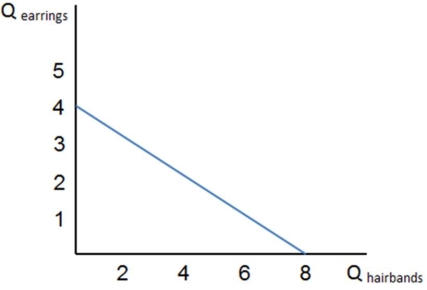 If the graph shown represents Stella's budget constraint,and she has income of $48 to spend on these two items,Stella could choose which consumption bundle?
If the graph shown represents Stella's budget constraint,and she has income of $48 to spend on these two items,Stella could choose which consumption bundle?A) One pair of earrings and seven hairbands
B) Four pairs of earrings and eight hairbands
C) Three pairs of earrings and six hairbands
D) Two pairs of earrings and four hairbands

Unlock Deck
Unlock for access to all 130 flashcards in this deck.
Unlock Deck
k this deck
42
This table shows the different combinations of goods that Jack can consume,given that his income to spend on these two items is $10.  Considering the information in the table shown,if Jack consumes 3 popsicles and 1 ice cream cone,then:
Considering the information in the table shown,if Jack consumes 3 popsicles and 1 ice cream cone,then:
A) Jack still has $5 left to spend.
B) the price of ice cream must have increased to $8.
C) the price of popsicles must have decreased.
D) None of these is true.
 Considering the information in the table shown,if Jack consumes 3 popsicles and 1 ice cream cone,then:
Considering the information in the table shown,if Jack consumes 3 popsicles and 1 ice cream cone,then:A) Jack still has $5 left to spend.
B) the price of ice cream must have increased to $8.
C) the price of popsicles must have decreased.
D) None of these is true.

Unlock Deck
Unlock for access to all 130 flashcards in this deck.
Unlock Deck
k this deck
43
 If the graph shown represents Taylor's budget constraint,which of the following consumption bundles could Taylor choose?
If the graph shown represents Taylor's budget constraint,which of the following consumption bundles could Taylor choose?A) Taylor cannot choose to consume any of these bundles
B) Two pairs of earrings and six hairbands
C) One pair of earrings and six hairbands
D) Four pairs of earrings and eight hairbands

Unlock Deck
Unlock for access to all 130 flashcards in this deck.
Unlock Deck
k this deck
44
A budget constraint:
A) shows a constant dollar amount spent on different combinations of goods, and each bundle brings the same utility.
B) shows a constant dollar amount spent on different combinations of goods, and each bundle brings a different amount of utility.
C) shows a constant amount of utility gained by consuming different combinations of goods, and each bundle costs the same.
D) None of these is true.
A) shows a constant dollar amount spent on different combinations of goods, and each bundle brings the same utility.
B) shows a constant dollar amount spent on different combinations of goods, and each bundle brings a different amount of utility.
C) shows a constant amount of utility gained by consuming different combinations of goods, and each bundle costs the same.
D) None of these is true.

Unlock Deck
Unlock for access to all 130 flashcards in this deck.
Unlock Deck
k this deck
45
A budget constraint:
A) is the same across all individuals with the same income constraints.
B) is different for each individual with the same income constraints.
C) is the same across all individuals with the same tastes and preferences.
D) is different for each individual with the same tastes and preferences.
A) is the same across all individuals with the same income constraints.
B) is different for each individual with the same income constraints.
C) is the same across all individuals with the same tastes and preferences.
D) is different for each individual with the same tastes and preferences.

Unlock Deck
Unlock for access to all 130 flashcards in this deck.
Unlock Deck
k this deck
46
Courtney goes for an hour bike ride which yields a marginal utility of 8.She stops and gets an ice cream cone,and then rides her bike for another hour.We can say:
A) the utility gained from a second ice cream cone was more than a second hour of bike riding.
B) the utility gained from the ice cream was more than 8.
C) the utility gained from the ice cream was less than the second hour of bike riding.
D) the utility gained from a third hour of biking would be less than the utility gained from the one ice cream.
A) the utility gained from a second ice cream cone was more than a second hour of bike riding.
B) the utility gained from the ice cream was more than 8.
C) the utility gained from the ice cream was less than the second hour of bike riding.
D) the utility gained from a third hour of biking would be less than the utility gained from the one ice cream.

Unlock Deck
Unlock for access to all 130 flashcards in this deck.
Unlock Deck
k this deck
47
This table shows the different combinations of goods that Jack can consume,given that his income to spend on these two items is $10.  Considering the information in the table shown,if Jack consumes 2 popsicles and 2 ice cream cones:
Considering the information in the table shown,if Jack consumes 2 popsicles and 2 ice cream cones:
A) Jack still has $4 left to spend.
B) Jack still has $6 left to spend.
C) Jack still has $8 left to spend.
D) Jack still has $2 left to spend.
 Considering the information in the table shown,if Jack consumes 2 popsicles and 2 ice cream cones:
Considering the information in the table shown,if Jack consumes 2 popsicles and 2 ice cream cones:A) Jack still has $4 left to spend.
B) Jack still has $6 left to spend.
C) Jack still has $8 left to spend.
D) Jack still has $2 left to spend.

Unlock Deck
Unlock for access to all 130 flashcards in this deck.
Unlock Deck
k this deck
48
This table shows the different combinations of goods that Jack can consume,given that his income to spend on these two items is $10.  Considering the information in the table shown,if Jack decides to consume bundle D,we can conclude that Jack:
Considering the information in the table shown,if Jack decides to consume bundle D,we can conclude that Jack:
A) still has money left to spend.
B) is not maximizing his utility.
C) could consume more of both goods.
D) All of these are true.
 Considering the information in the table shown,if Jack decides to consume bundle D,we can conclude that Jack:
Considering the information in the table shown,if Jack decides to consume bundle D,we can conclude that Jack:A) still has money left to spend.
B) is not maximizing his utility.
C) could consume more of both goods.
D) All of these are true.

Unlock Deck
Unlock for access to all 130 flashcards in this deck.
Unlock Deck
k this deck
49
This table shows the different combinations of goods that Jack can consume,given that his income to spend on these two items is $10.  Considering the information in the table shown,Jack's total utility from consuming bundle D would be:
Considering the information in the table shown,Jack's total utility from consuming bundle D would be:
A) 1,160.
B) 1,300.
C) 950.
D) 2,220.
 Considering the information in the table shown,Jack's total utility from consuming bundle D would be:
Considering the information in the table shown,Jack's total utility from consuming bundle D would be:A) 1,160.
B) 1,300.
C) 950.
D) 2,220.

Unlock Deck
Unlock for access to all 130 flashcards in this deck.
Unlock Deck
k this deck
50
Zachary spends his day studying for a total of four hours and exercising for one hour.Using the concept of utility to explain his choices,we can say
A) the total utility gained from exercising for one hour is greater than the total utility from studying for four hours.
B) the marginal utility of exercising for the first hour was greater than the marginal utility of studying for the first hour.
C) the marginal utility of studying for a fifth hour will be negative.
D) the marginal utility from studying for a fifth hour is less than the marginal utility from the first hour of exercise.
A) the total utility gained from exercising for one hour is greater than the total utility from studying for four hours.
B) the marginal utility of exercising for the first hour was greater than the marginal utility of studying for the first hour.
C) the marginal utility of studying for a fifth hour will be negative.
D) the marginal utility from studying for a fifth hour is less than the marginal utility from the first hour of exercise.

Unlock Deck
Unlock for access to all 130 flashcards in this deck.
Unlock Deck
k this deck
51
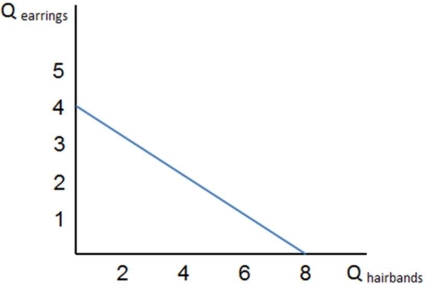 If the graph shown represents Stella's budget constraint,and hairbands cost $4,what must Stella's income to spend on these two items be?
If the graph shown represents Stella's budget constraint,and hairbands cost $4,what must Stella's income to spend on these two items be?A) $32
B) $16
C) $48
D) Cannot answer this question without more information.

Unlock Deck
Unlock for access to all 130 flashcards in this deck.
Unlock Deck
k this deck
52
A budget constraint is:
A) a line that is composed of all the possible combinations of goods and services that maximize a consumer's total utility.
B) a line that is composed of the additional utility gained from consuming possible combinations of goods and services that a consumer can buy with his or her income.
C) a line that is composed of all the possible combinations of goods and services that a consumer can buy with his or her income.
D) a line that is composed of the total utility gained from consuming all possible combinations of goods and services that a consumer can buy with his or her income.
A) a line that is composed of all the possible combinations of goods and services that maximize a consumer's total utility.
B) a line that is composed of the additional utility gained from consuming possible combinations of goods and services that a consumer can buy with his or her income.
C) a line that is composed of all the possible combinations of goods and services that a consumer can buy with his or her income.
D) a line that is composed of the total utility gained from consuming all possible combinations of goods and services that a consumer can buy with his or her income.

Unlock Deck
Unlock for access to all 130 flashcards in this deck.
Unlock Deck
k this deck
53
This table shows the different combinations of goods that Jack can consume,given that his income to spend on these two items is $10.  Considering the information in the table shown,if we assume Jack is a rational utility maximizer,then we can predict he will buy which bundle with his $10?
Considering the information in the table shown,if we assume Jack is a rational utility maximizer,then we can predict he will buy which bundle with his $10?
A) A
B) B
C) C
D) D
 Considering the information in the table shown,if we assume Jack is a rational utility maximizer,then we can predict he will buy which bundle with his $10?
Considering the information in the table shown,if we assume Jack is a rational utility maximizer,then we can predict he will buy which bundle with his $10?A) A
B) B
C) C
D) D

Unlock Deck
Unlock for access to all 130 flashcards in this deck.
Unlock Deck
k this deck
54
When someone is served pizza and soda for dinner,it is typical behavior to eat some pizza,then drink some soda,then eat more pizza,and so on,until the person stops consuming both.How can this behavior be explained using economic concepts?
A) The individual is revealing that he can't decide whether he gains more utility from pizza or from soda.
B) People tend to act irrationally around food, and the concept of utility maximization cannot be applied.
C) The person eats pizza until his marginal utility for pizza is lower than it is for soda, then he switches to soda.
D) The concept of unlimited wants says he will never tire of eating pizza and soda.
A) The individual is revealing that he can't decide whether he gains more utility from pizza or from soda.
B) People tend to act irrationally around food, and the concept of utility maximization cannot be applied.
C) The person eats pizza until his marginal utility for pizza is lower than it is for soda, then he switches to soda.
D) The concept of unlimited wants says he will never tire of eating pizza and soda.

Unlock Deck
Unlock for access to all 130 flashcards in this deck.
Unlock Deck
k this deck
55
This table shows the different combinations of goods that Jack can consume,given that his income to spend on these two items is $10.  Considering the information in the table shown,the price of ice cream is:
Considering the information in the table shown,the price of ice cream is:
A) $2 per cone.
B) $1 per cone.
C) diminishing as Jack increases the amount consumed.
D) $5 per cone.
 Considering the information in the table shown,the price of ice cream is:
Considering the information in the table shown,the price of ice cream is:A) $2 per cone.
B) $1 per cone.
C) diminishing as Jack increases the amount consumed.
D) $5 per cone.

Unlock Deck
Unlock for access to all 130 flashcards in this deck.
Unlock Deck
k this deck
56
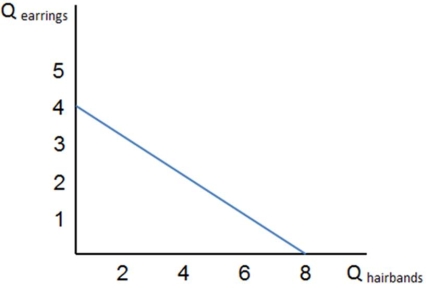 The slope of the budget line in the graph shown:
The slope of the budget line in the graph shown:A) represents the opportunity cost of the two goods relative to each other.
B) represents the relative marginal utilities from consuming the two goods.
C) measures the total utility the consumer gets from consuming the two goods.
D) is the consumer's income level.

Unlock Deck
Unlock for access to all 130 flashcards in this deck.
Unlock Deck
k this deck
57
A budget constraint:
A) shows different bundles of goods that all yield the same total utility.
B) shows different bundles of goods that all cost the same amount.
C) shows different bundles of goods that all maximize an individual's utility.
D) shows how much income is needed to maximize total utility.
A) shows different bundles of goods that all yield the same total utility.
B) shows different bundles of goods that all cost the same amount.
C) shows different bundles of goods that all maximize an individual's utility.
D) shows how much income is needed to maximize total utility.

Unlock Deck
Unlock for access to all 130 flashcards in this deck.
Unlock Deck
k this deck
58
You decide to forgo a third slice of pizza and have a scoop of ice cream instead.This is an example of the economic concept of:
A) diminishing marginal utility.
B) altruism.
C) reciprocity.
D) selfishness.
A) diminishing marginal utility.
B) altruism.
C) reciprocity.
D) selfishness.

Unlock Deck
Unlock for access to all 130 flashcards in this deck.
Unlock Deck
k this deck
59
Dave and Buster play two games of tennis,and then decide to go have lunch.Using the concept of utility to explain their choices,we can conclude that:
A) they each won one game of tennis.
B) the marginal utility from playing a third game must be negative for them.
C) the marginal utility from playing a third game must be less than the marginal utility from having lunch.
D) All of these must be true.
A) they each won one game of tennis.
B) the marginal utility from playing a third game must be negative for them.
C) the marginal utility from playing a third game must be less than the marginal utility from having lunch.
D) All of these must be true.

Unlock Deck
Unlock for access to all 130 flashcards in this deck.
Unlock Deck
k this deck
60
This table shows the different combinations of goods that Jack can consume,given that his income to spend on these two items is $10.  Considering the information in the table shown,the bundle of goods that will derive the highest total utility for Jack is:
Considering the information in the table shown,the bundle of goods that will derive the highest total utility for Jack is:
A)E.
B)B.
C)C.
D)D.
 Considering the information in the table shown,the bundle of goods that will derive the highest total utility for Jack is:
Considering the information in the table shown,the bundle of goods that will derive the highest total utility for Jack is:A)E.
B)B.
C)C.
D)D.

Unlock Deck
Unlock for access to all 130 flashcards in this deck.
Unlock Deck
k this deck
61
 Assume Bryce's budget constraint is represented by line C in the graph shown.Which of the following would cause Bryce's budget constraint to shift to A?
Assume Bryce's budget constraint is represented by line C in the graph shown.Which of the following would cause Bryce's budget constraint to shift to A?A) Bryce's income increased.
B) Bryce's income decreased.
C) Bryce's preferences for books and movies decreased.
D) Bryce's preferences for books and movies increased.

Unlock Deck
Unlock for access to all 130 flashcards in this deck.
Unlock Deck
k this deck
62
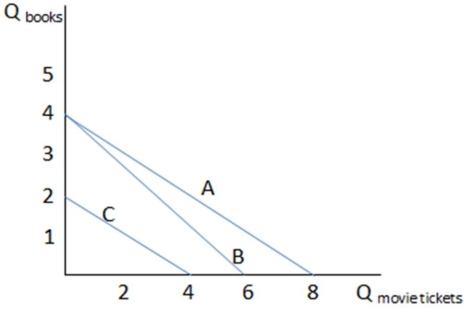 Assume Kevin's income to spend on the two goods in the graph shown is $48,and books cost $12.If Kevin's budget constraint is one of the lines in the graph,which one must it be?
Assume Kevin's income to spend on the two goods in the graph shown is $48,and books cost $12.If Kevin's budget constraint is one of the lines in the graph,which one must it be?A)A
B)B
C)C
D)It could be either A or B.

Unlock Deck
Unlock for access to all 130 flashcards in this deck.
Unlock Deck
k this deck
63
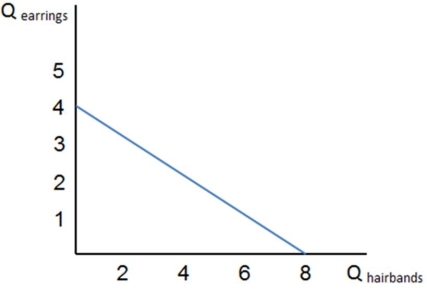 Assume Bridget's budget constraint is shown in the graph shown.If she has $48 to spend on these two items,then earrings must cost:
Assume Bridget's budget constraint is shown in the graph shown.If she has $48 to spend on these two items,then earrings must cost:A) $8.
B) $6.
C) $4.
D) $12.

Unlock Deck
Unlock for access to all 130 flashcards in this deck.
Unlock Deck
k this deck
64
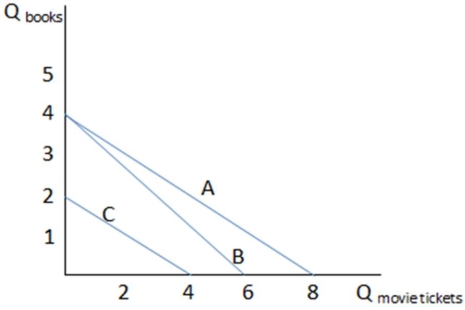 Assume Bryce's budget constraint is represented by line B in the graph shown.Which of the following would cause Bryce's budget constraint to shift to A?
Assume Bryce's budget constraint is represented by line B in the graph shown.Which of the following would cause Bryce's budget constraint to shift to A?A) The price of books increased.
B) The price of books decreased.
C) The price of movie tickets increased.
D) The price of movie tickets decreased.

Unlock Deck
Unlock for access to all 130 flashcards in this deck.
Unlock Deck
k this deck
65
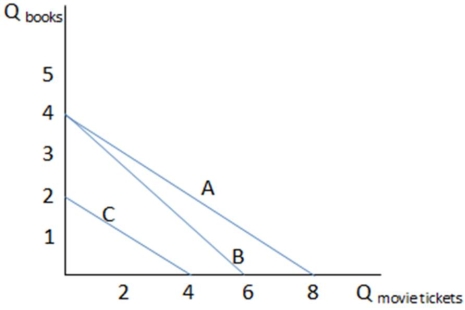 Assume Kara's budget constraint is represented by line A in the graph shown,and that her income to spend on these two items is $24.What would cause her budget constraint to move to B?
Assume Kara's budget constraint is represented by line A in the graph shown,and that her income to spend on these two items is $24.What would cause her budget constraint to move to B?A) The price of movie tickets falls to $4.
B) The price of movie tickets increases to $4.
C) The price of movie tickets falls to $6.
D) The price of movie tickets increases to $6.

Unlock Deck
Unlock for access to all 130 flashcards in this deck.
Unlock Deck
k this deck
66
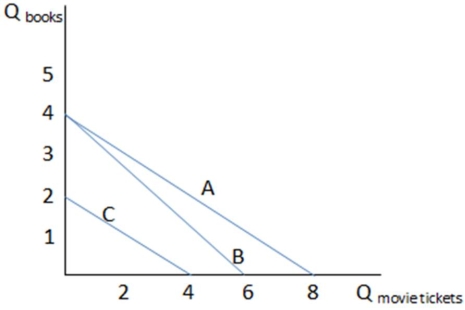 Assume Claudia's budget constraint is demonstrated by line A in the graph shown.Which of the following would cause Claudia's budget constraint to shift to line C?
Assume Claudia's budget constraint is demonstrated by line A in the graph shown.Which of the following would cause Claudia's budget constraint to shift to line C?A) Claudia's income increased.
B) Claudia's income decreased.
C) Claudia's preferences for these two goods decreased.
D) The prices of both goods have gone down.

Unlock Deck
Unlock for access to all 130 flashcards in this deck.
Unlock Deck
k this deck
67
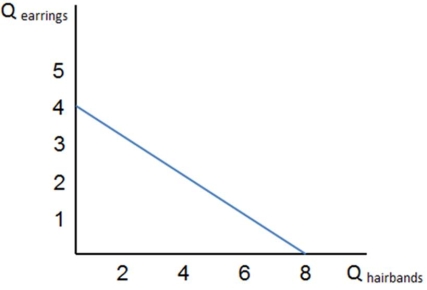 If the graph shown represents Tina's budget constraint,which of the following consumption bundles can Tina not afford?
If the graph shown represents Tina's budget constraint,which of the following consumption bundles can Tina not afford?A) Three pairs of earrings and four hairbands
B) Two pairs of earrings and four hairbands
C) No earrings and six hairbands
D) Cannot answer this question without knowing Tina's income and the prices of the two goods

Unlock Deck
Unlock for access to all 130 flashcards in this deck.
Unlock Deck
k this deck
68
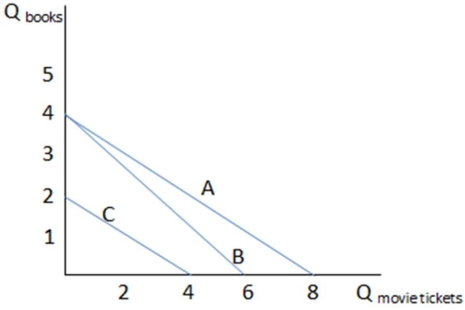 Assume Alan's budget constraint is demonstrated by line A in the graph shown.Which of the following could cause Alan's budget constraint to change to line B?
Assume Alan's budget constraint is demonstrated by line A in the graph shown.Which of the following could cause Alan's budget constraint to change to line B?A) Alan could have experienced a drop in income.
B) The price of books could have increased.
C) Alan could have decided he doesn't like going to the movies as much as he used to.
D) The price of movie tickets could have increased.

Unlock Deck
Unlock for access to all 130 flashcards in this deck.
Unlock Deck
k this deck
69
 Assume Claudia's budget constraint is demonstrated by line A in the graph shown.Which of the following would cause Claudia's budget constraint to shift to line C?
Assume Claudia's budget constraint is demonstrated by line A in the graph shown.Which of the following would cause Claudia's budget constraint to shift to line C?A) The price of books dropped.
B) The price of movie tickets dropped.
C) Claudia's preferences for these two goods decreased.
D) Claudia's income decreased.

Unlock Deck
Unlock for access to all 130 flashcards in this deck.
Unlock Deck
k this deck
70
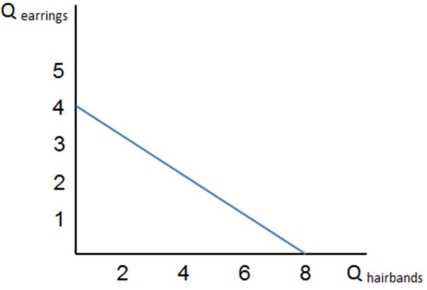 Assume Bonnie has $64 to spend on hairbands and earrings.Her budget constraint is shown in the graph shown.Which of the following can be said about Bonnie's choices?
Assume Bonnie has $64 to spend on hairbands and earrings.Her budget constraint is shown in the graph shown.Which of the following can be said about Bonnie's choices?A) Bonnie can buy twice as many hairbands as earrings.
B) Earrings must cost $16 each.
C) Hairbands must cost $8 each.
D) All of these are true.

Unlock Deck
Unlock for access to all 130 flashcards in this deck.
Unlock Deck
k this deck
71
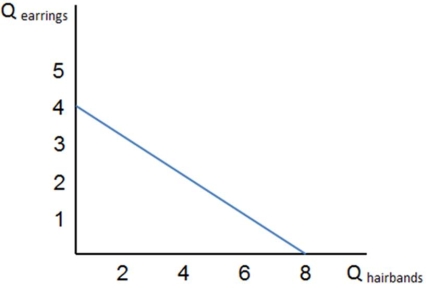 Assume Mimi's budget constraint is shown in the graph shown.If earrings cost $7,then hairbands must cost:
Assume Mimi's budget constraint is shown in the graph shown.If earrings cost $7,then hairbands must cost:A) $3.50.
B) $7.
C) $5.25.
D) $4.

Unlock Deck
Unlock for access to all 130 flashcards in this deck.
Unlock Deck
k this deck
72
This graph shows three different budget constraints: A,B,and C. 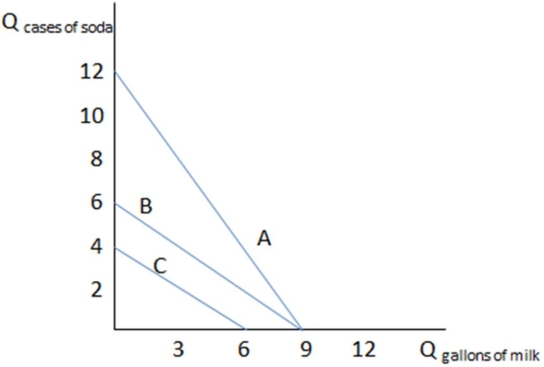
If Don has budget constraint C in the graph shown,what is the trade-off he faces in terms of the two goods?
A)Two cases of soda for every three gallons of milk
B)One case of soda for every one and a half gallons of milk
C)Three cases of soda for every four and a half gallons of milk
D)All of these accurately reflect Don's tradeoff.

If Don has budget constraint C in the graph shown,what is the trade-off he faces in terms of the two goods?
A)Two cases of soda for every three gallons of milk
B)One case of soda for every one and a half gallons of milk
C)Three cases of soda for every four and a half gallons of milk
D)All of these accurately reflect Don's tradeoff.

Unlock Deck
Unlock for access to all 130 flashcards in this deck.
Unlock Deck
k this deck
73
 Assume Willow's income to spend on either earrings or hairbands is $24.If her budget constraint is pictured in the graph shown,which of the following must be true?
Assume Willow's income to spend on either earrings or hairbands is $24.If her budget constraint is pictured in the graph shown,which of the following must be true?A) Willow will buy more hairbands than earrings because they are less expensive.
B) Willow will buy more earrings than hairbands because they are less expensive.
C) Hairbands must cost $3, and earrings must cost $6.
D) Hairbands must cost $8, and earrings must cost $4.

Unlock Deck
Unlock for access to all 130 flashcards in this deck.
Unlock Deck
k this deck
74
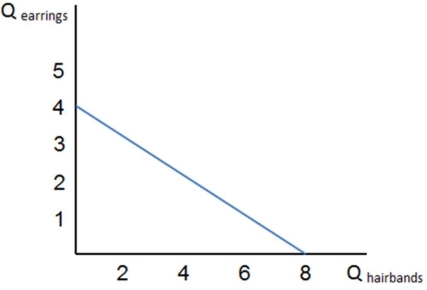 Assume the graph shown shows Bobbi's budget constraint.If hairbands cost $5,then Bobbi's income to spend on these two items must be:
Assume the graph shown shows Bobbi's budget constraint.If hairbands cost $5,then Bobbi's income to spend on these two items must be:A) $8.
B) $6.
C) $40.
D) Cannot be determined without more information.

Unlock Deck
Unlock for access to all 130 flashcards in this deck.
Unlock Deck
k this deck
75
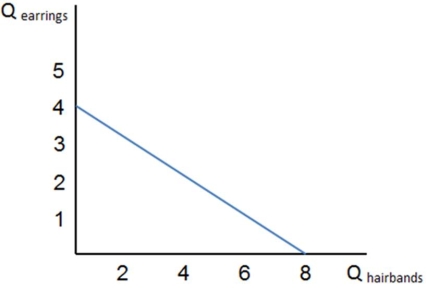 If the graph shown represents Celia's budget constraint,which of the following must be true?
If the graph shown represents Celia's budget constraint,which of the following must be true?A) Celia will spend twice as much on earrings as she does hairbands.
B) Celia could consume either four pairs of earrings or eight hairbands.
C) Celia gets twice as much utility from earrings as she does from hairbands.
D) All of these are true.

Unlock Deck
Unlock for access to all 130 flashcards in this deck.
Unlock Deck
k this deck
76
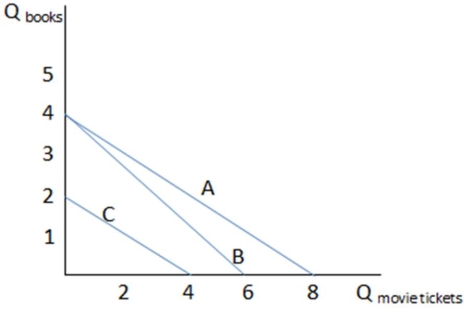 Assume Roger's income to spend on books and movie tickets is $48,and his budget constraint is represented by line
Assume Roger's income to spend on books and movie tickets is $48,and his budget constraint is represented by lineA)Roger gets a raise at work.
B)Roger gets unlimited coupons for $2 off the price of a movie ticket.
C)The price of movie tickets increases to $8.
D)None of these changes would cause Roger's budget constraint to move from B to A.

Unlock Deck
Unlock for access to all 130 flashcards in this deck.
Unlock Deck
k this deck
77
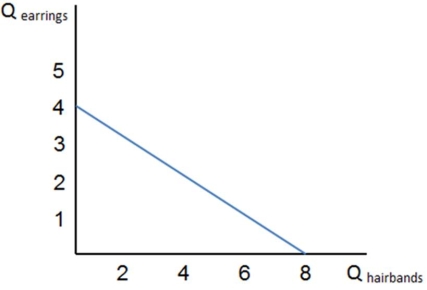 Assume the graph shown represents Grace's budget constraint.Which of the following is true?
Assume the graph shown represents Grace's budget constraint.Which of the following is true?A) Grace's total utility is constant along her budget constraint.
B) Grace's marginal utility of each good is the same for each combination of goods on her budget line.
C) Grace's total expenditure is constant along her budget constraint.
D) Grace is indifferent between consuming any bundle that lies on the budget constraint.

Unlock Deck
Unlock for access to all 130 flashcards in this deck.
Unlock Deck
k this deck
78
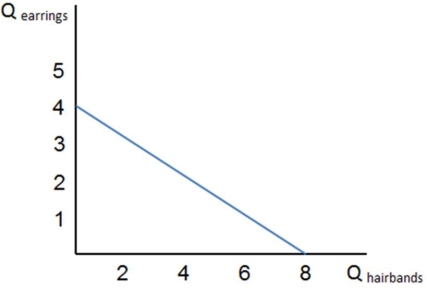 If the graph shown represents Suzi's budget constraint,what can be said about hairbands?
If the graph shown represents Suzi's budget constraint,what can be said about hairbands?A) They cost twice as much as earrings.
B) They cost half as much as earrings.
C) Suzi likes hairbands more than earrings.
D) Suzi is willing to pay twice as much for hairbands.

Unlock Deck
Unlock for access to all 130 flashcards in this deck.
Unlock Deck
k this deck
79
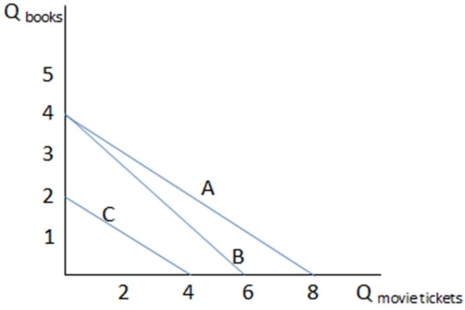 Assume Bill's income to spend on the two goods in the graph shown is $48,and movie tickets cost $8.If Bill's budget constraint is one of the lines in the graph,which one must it be?
Assume Bill's income to spend on the two goods in the graph shown is $48,and movie tickets cost $8.If Bill's budget constraint is one of the lines in the graph,which one must it be?A)A
B)B
C)C
D)It could be line A or B.

Unlock Deck
Unlock for access to all 130 flashcards in this deck.
Unlock Deck
k this deck
80
 Assume Alan's budget constraint is demonstrated by line A in the graph shown.Which of the following could cause Alan's budget constraint to change to line B?
Assume Alan's budget constraint is demonstrated by line A in the graph shown.Which of the following could cause Alan's budget constraint to change to line B?A) The price of books could have decreased.
B) The price of books could have increased.
C) The price of movie tickets could have increased.
D) The price of movie tickets could have decreased.

Unlock Deck
Unlock for access to all 130 flashcards in this deck.
Unlock Deck
k this deck



